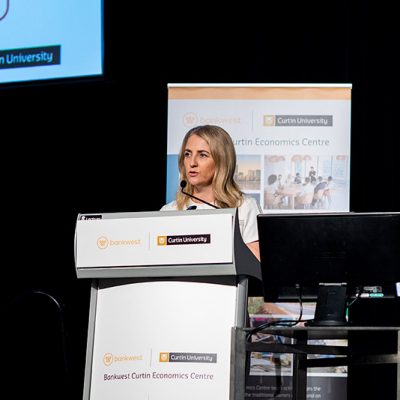Over a quarter of a century until gender pay gap likely to close

Alan Duncan, Director
Joanna Holcombe, Industry Engagement Coordinator
— Consistency is the key to implementing gender equality policies and practices —
— Mining sector the big improver in gender equality practices —
— Regular pay gap audits lead to faster closing of managerial pay gaps —
A new report shows that although progress has been made in recent years to reduce the gender pay gap in Australia, it will still take more than a quarter of a century to close it.
Research released today by the Bankwest Curtin Economics Centre and the Workplace Gender Equality Agency (WGEA) found that while the total remuneration gender pay gap fell from 24.7 per cent to 20.1 per cent in the last seven years, it is likely to take another 26 years for the full-time total remuneration gender pay gap to close completely.
The report, Gender Equity Insights 2021: Making it a Priority, revealed that the gender pay gap for executives could disappear in the next decade but the outlook was less positive for the predominantly female-dominated community and personal service workers.
Report author and Bankwest Curtin Economics Centre Deputy Director Associate Professor Rebecca Cassells said if the average annual rate of change continued, the gender pay gap among full-time executives would be eliminated within 10 years, and for senior managers in less than 15 years.
“For workers in non-management roles, it could take even longer. Some occupations may not see any change at all in their gender pay gap in the coming years,” Associate Professor Cassells said.
“Our report showed organisations that implemented a comprehensive suite of gender equality policy and practice measures and did so consistently over time achieved lower gender pay gaps and, more women in senior leadership roles.
“We also found finance and insurance, utilities and mining companies are the most likely to adhere to best gender equity practices, with the mining sector being the biggest improver in recent years, while businesses in the health care and social assistance sector are only a quarter as likely to adhere to best practice.”
Libby Lyons, Director of the Workplace Gender Equality Agency, said that the report highlighted the importance of Australian businesses taking action to improve gender equality outcomes.
“The findings of last year’s WGEA dataset showed that progress on gender equality had stalled in Australian workplaces. This report reveals a worrying level of apathy and indifference among many Australian employers towards improving gender equality outcomes in their organisations,” Ms Lyons said.
“Expecting Australian women to wait a quarter of a century for the total remuneration gender pay gap to close is unacceptable. It may well take longer if employer inertia and complacency lead to a reversal of current trends. We also have to consider the effect that the COVID-19 pandemic may have on the outlook for women’s employment and workforce participation. This will remain unclear until we collect the data from employers in the coming months and release our next dataset later this year.
“Employers must act now to embed gender equality in their organisations as a standard business practice. Not only will it drive better company performance, productivity and profitability but it will also deliver meaningful, systemic change that will close the gender pay gap faster and make our workplaces better, fairer and safer for both women and men.”
Report co-author and Bankwest Curtin Economics Centre Director John Curtin Distinguished Professor Alan Duncan said despite recent progress toward gender equality there was considerable evidence of a degree of apathy and inaction among Australia’s biggest organisations.
“An example of this is the diminishing efforts to narrow the gender pay gap through regular audits, the rate of which has slowed significantly, with more than half of reporting organisations not undertaking a regular pay gap analysis,” Professor Duncan said.
“The managerial gender pay gap grew an extra 5.1 percentage points among those organisations that ceased regular pay gap audits, but decreased by 2.2 percentage points for organisations that consistently examined how they were paying women and men.”
“What’s more, organisations with a higher concentration of women tend to be the most apathetic. This is even evident when looking at Board representation, where male-dominated industries are more likely to be closer to having a proportionate representation of women on Boards than many female-dominated sectors.
“What we do know is that targets work. Organisations that have set consistent targets for appointing women on to boards, increase the share of female Board members at twice the pace of those that set no targets.
“The risk of complacency is that we lose the hard-earned gains in improved gender equality outcomes.”
Key findings
- The gender pay gap has fallen from 24.7 per cent to 20.1 per cent and at this rate of change will take another 26 years for the full-time gender pay gap for total remuneration to close;
- A 4.4 percentage point reduction in the gender pay gap of managers between 2015 and 2020 and a 2.3 percentage point reduction for non-managers among companies that are the most consistent when it comes to gender equity policies and actions;
- A 1.4 percentage point reduction in the gender pay gap of managers for the same period and no change for non-managers among companies that are the least consistent when it comes to gender equity policies and actions;
- The mining sector was most improved for following the best gender equity practices with an increase of 8.4 points over the last five years;
- Organisations in the education and training, health care and social assistance sectors ranked lowest on average in terms of their approach to gender equity in the workplace, and showed least improvement over the last five years;
- The rate of pay audit actions has slowed, increasing by only 1.7 percentage points in the latest WGEA reporting data, while in previous years it has averaged growth of 3.7 percentage points;
- Organisations that consistently undertook pay gap audits saw their managerial gender pay gap narrow at a faster rate than other companies, by up to 2.2 percentage points between 2017 and 2020;
- Organisations that set consistent Board targets saw the share of women on Boards increase by 7.3 percentage points, lifting from 21.6 to 31.1 percent between 2015 and 2020; and
- An increase of only 3.5 percentage points for companies that did not set any targets for women on Boards.










